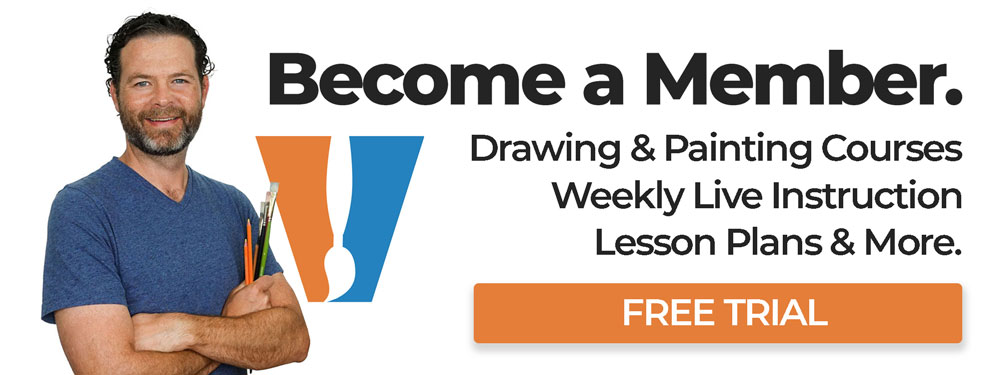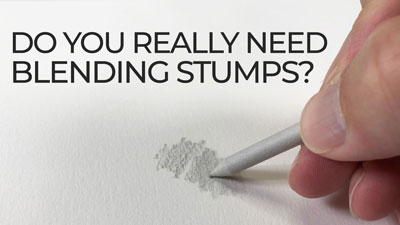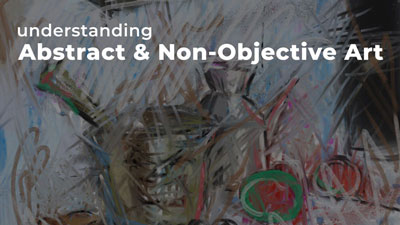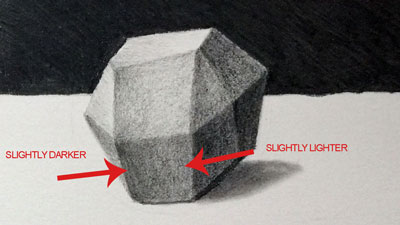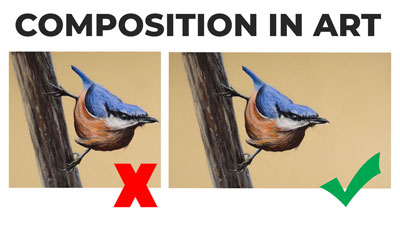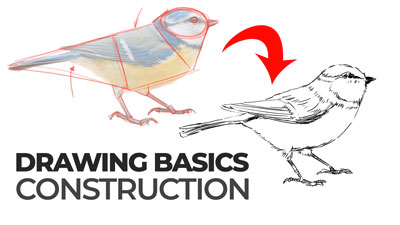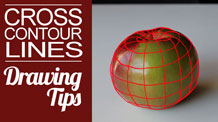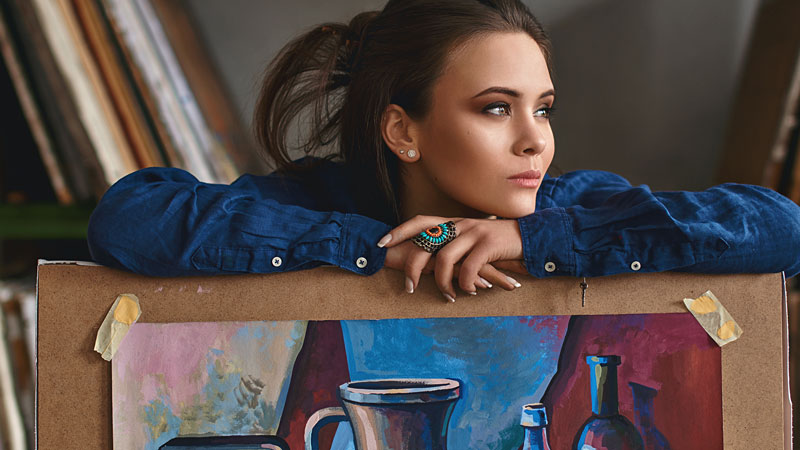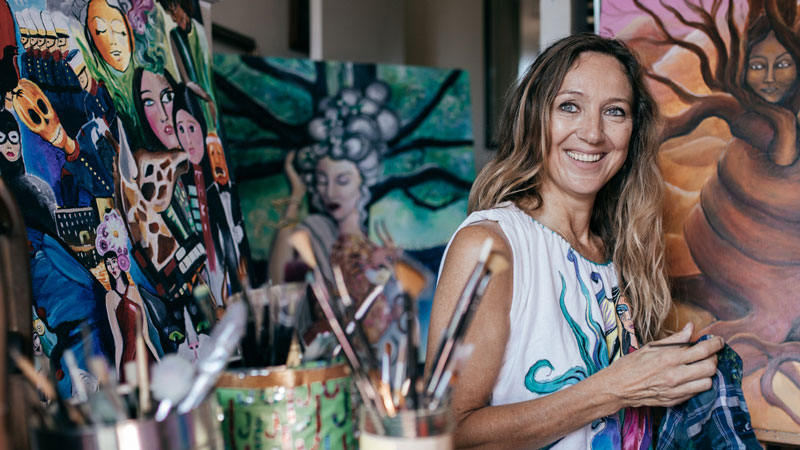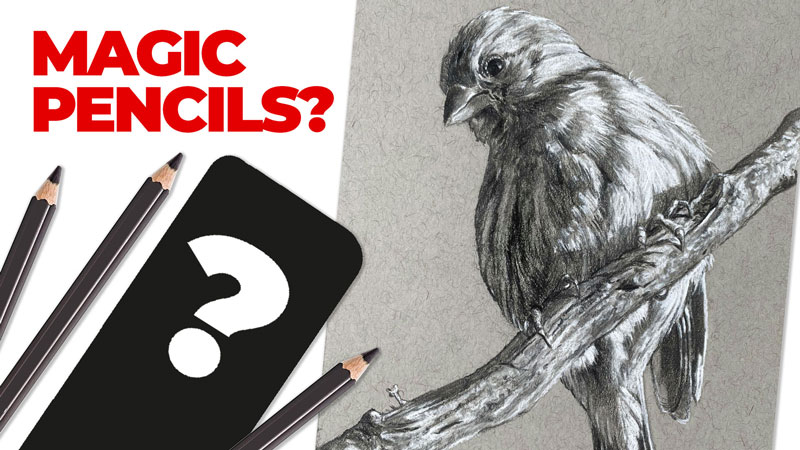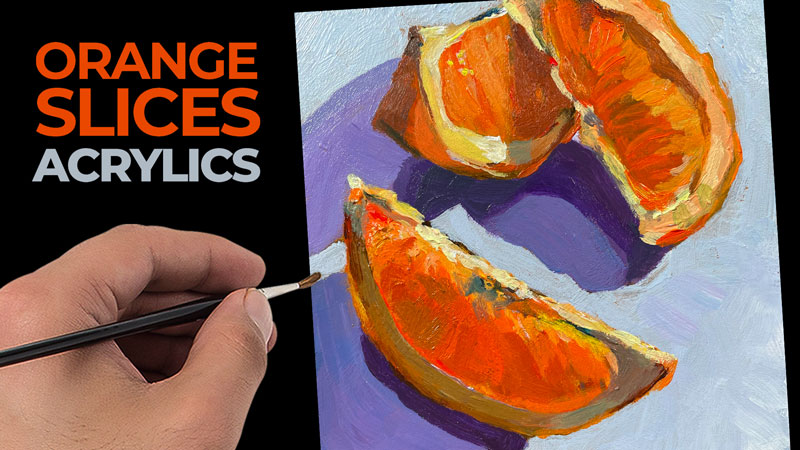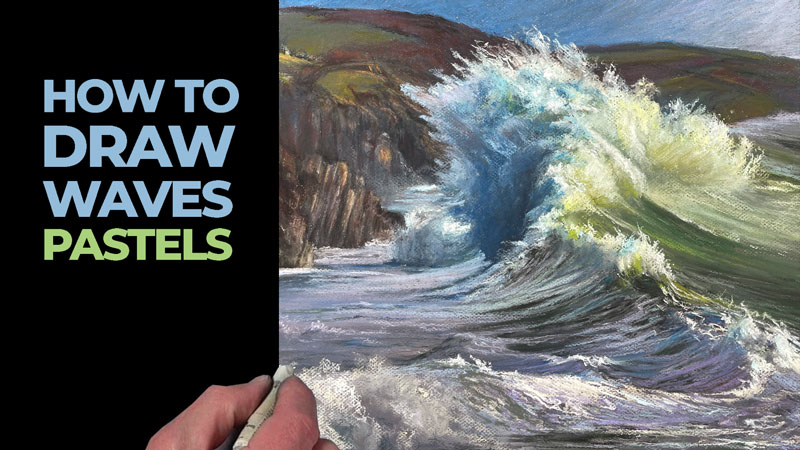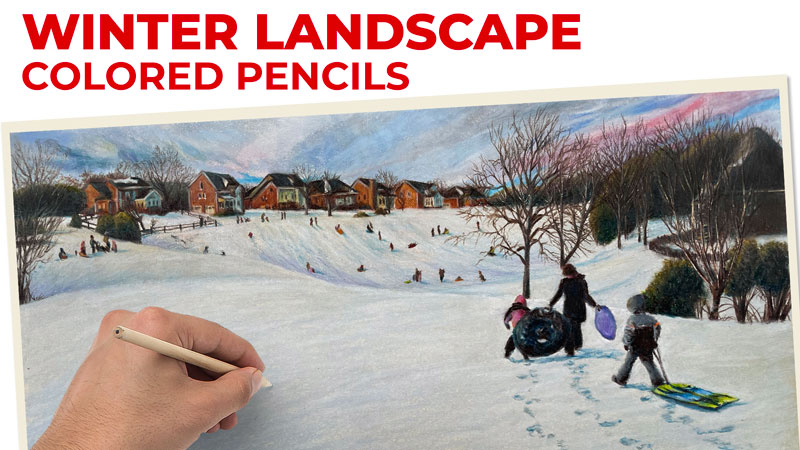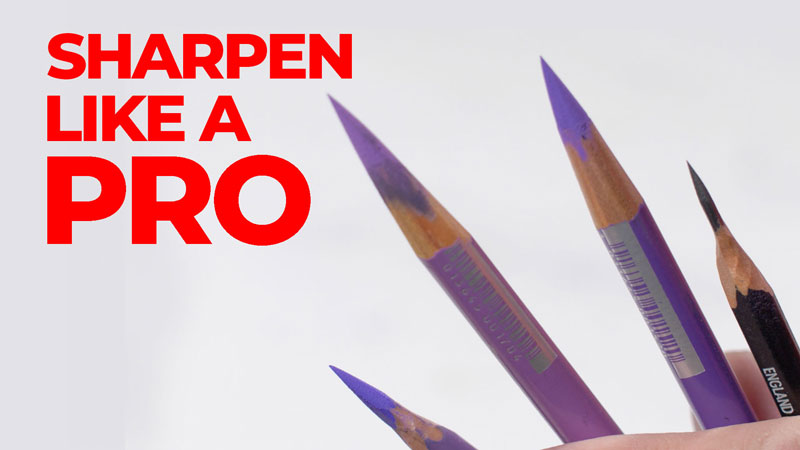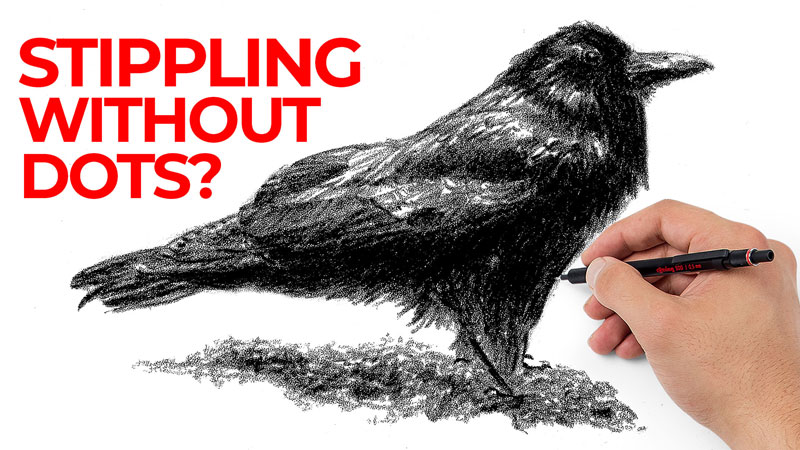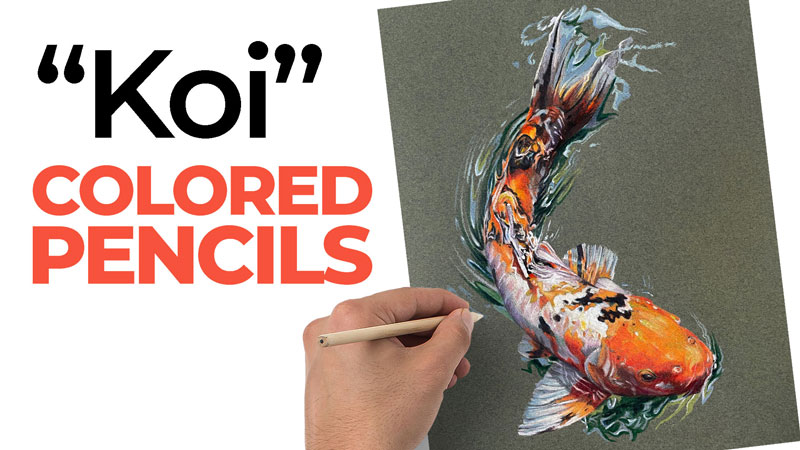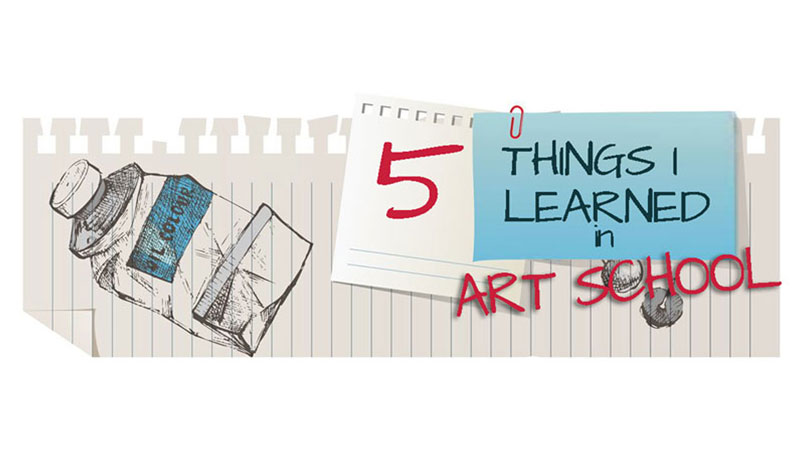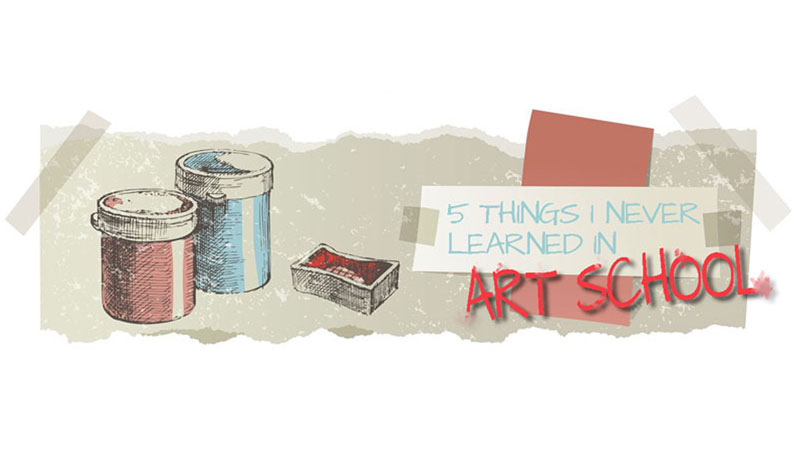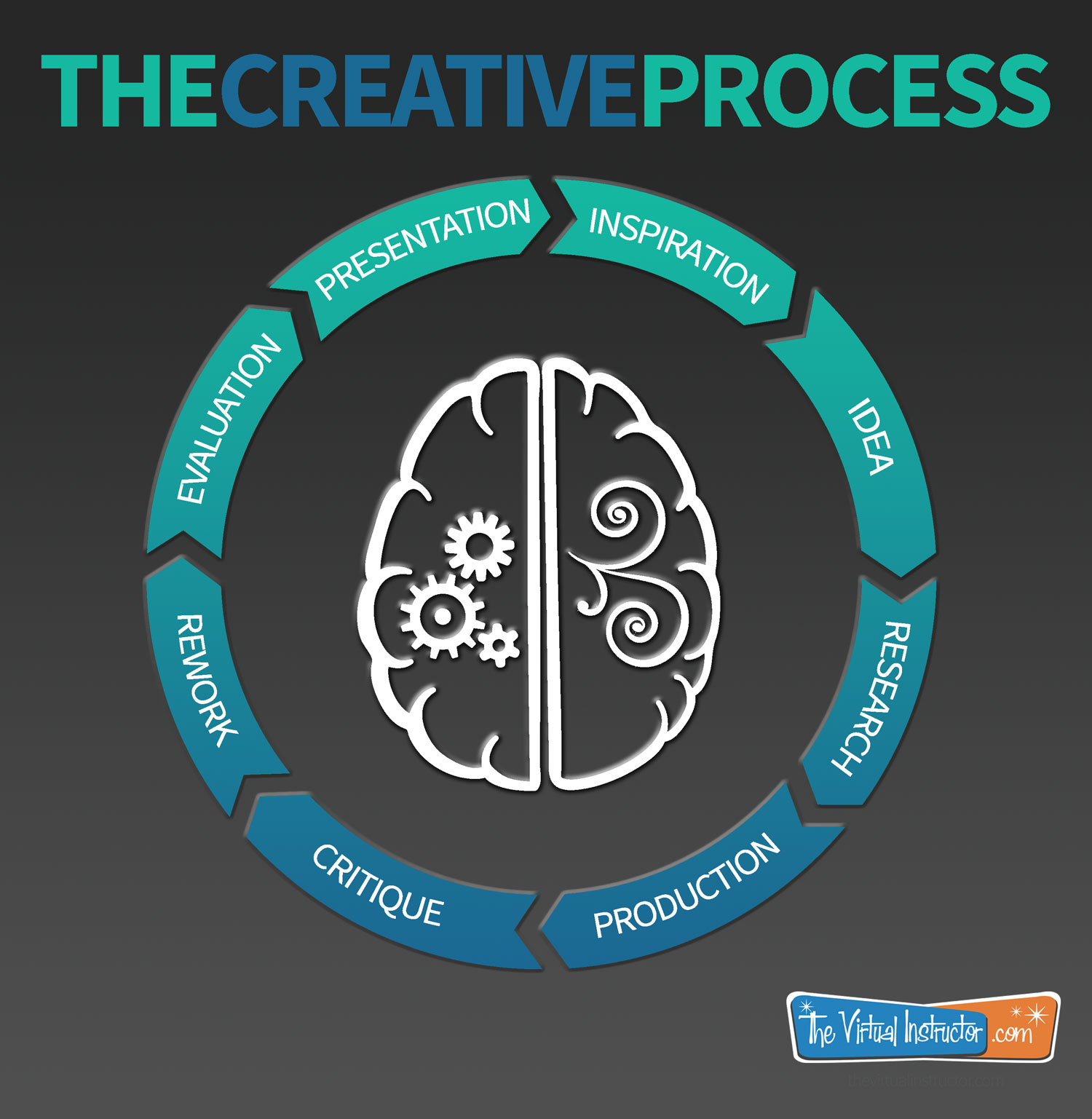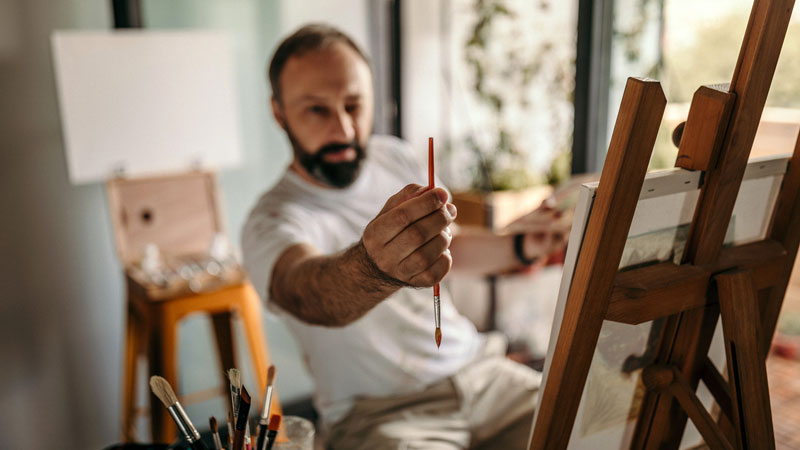
We hear it all the time – “Draw or paint what you see.”
Seems simple enough, right? Just look at whatever your subject may be and put it on the surface. Artists and art instructors are notorious for telling their students to “just draw what they see”, often leaving the student with a confused look on their face.
For those of us that already know what to look for, this infamous statement makes perfect sense. It seems simple, because it is simple.
Many students however, simply do not know what to look for to “draw what they see”. They may see a still life, a landscape, or a person, but they don’t understand how take the visual information and turn it into a representational drawing or painting.
But once they know and understand what needs to be observed and recorded in the art, the “light bulbs” turn on.
In this post, we’ll look at six things to look for when creating an observational drawing or painting, so that you can draw what you see. (You’ll notice a theme here – if you’re really sharp.)
Look For the Shapes
For many of us, the first things we notice are the lines. This is how most of us first learn how to draw so it makes sense that we seek these out initially. We see the edges of objects as lines, which are referred to as contour lines. Our first inclinations are to draw these lines first, which often leads to a distorted shape of the subject.
I suggest that we skip the lines at the onset and instead look for the shapes. Sure, we’ll use lines to draw the shapes, but starting a drawing or painting by identifying the shapes often leads to greater accuracy. Don’t worry, we’ll address the lines, but it’s often not the best place to start.
All subjects, no matter how complex they may be, can be simplified into basic shapes. By layering basic shapes and piecing them together, we can build the structure of the subject. The process of finding the shapes in your subject does take a bit of practice and training of your mind, but that’s what sketchbooks are for.
Here’s a simple example…
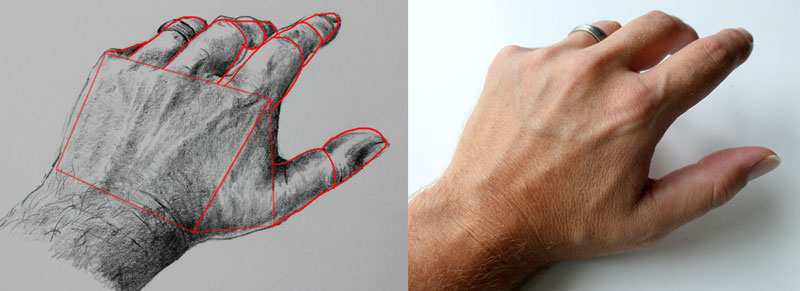 Oh yes – the hand. The subject of the hand strikes fear in every beginning artist because it is quite complex. But even this complex subject can be simplified into basic shapes that are quite easy to draw. It’s just a matter of identifying those shapes and piecing them together.
Oh yes – the hand. The subject of the hand strikes fear in every beginning artist because it is quite complex. But even this complex subject can be simplified into basic shapes that are quite easy to draw. It’s just a matter of identifying those shapes and piecing them together.
In the above example, a rectangle is drawn for the back of the hand. A triangle is drawn on the side of the rectangle, connecting the thumb. Organic shapes are drawn for each segment of the fingers.
As we draw the shapes, we can also make comparisons to the negative shapes that exist around the subject. These comparisons and the adjustments that are made, will further improve the accuracy of the drawing or painting.
Once the basic shapes are drawn and laid out, we can now move on to the next thing to look for – the lines.
Look For the Lines
Now that we’ve identified the shapes, we can move on to drawing or painting the lines. Since the overall shape of the subject has been defined, we can concentrate on the quality of line that is created, without worrying about the shape created by our contours (outlines).
Using the shapes as guidelines, we can add the contour lines adjusting the thickness and thinness of the mark to create variety and interest.
 The line quality that is produced not only enhances the visual interest, but also communicates the form and texture of the subject. When we observe the subject, we can pay close attention to subtle changes in the lines and add them, “as we see them”, in the drawing or painting.
The line quality that is produced not only enhances the visual interest, but also communicates the form and texture of the subject. When we observe the subject, we can pay close attention to subtle changes in the lines and add them, “as we see them”, in the drawing or painting.
Watch the leaf demonstration (Membership Required) –
Let’s move on to the next thing to look for – value.
Look For the Values
It is important to note that the next few things that we’ll be looking for in our subject are all dependent on one another. So they may be all observed concurrently since they influence each other. We’ll start with value, since it is the greatest influencer of the other two. And if the value is accurate, then texture and form just “fall into place”.
Value is defined as the darkness or lightness of a color. It is how we actually see the important parts of the world around us. It is the value that tells us about the light, forms, and textures of the environment around us.
Finding the dark, light, and middle values in your subject and adding them in the correct locations in the art leads to accuracy.
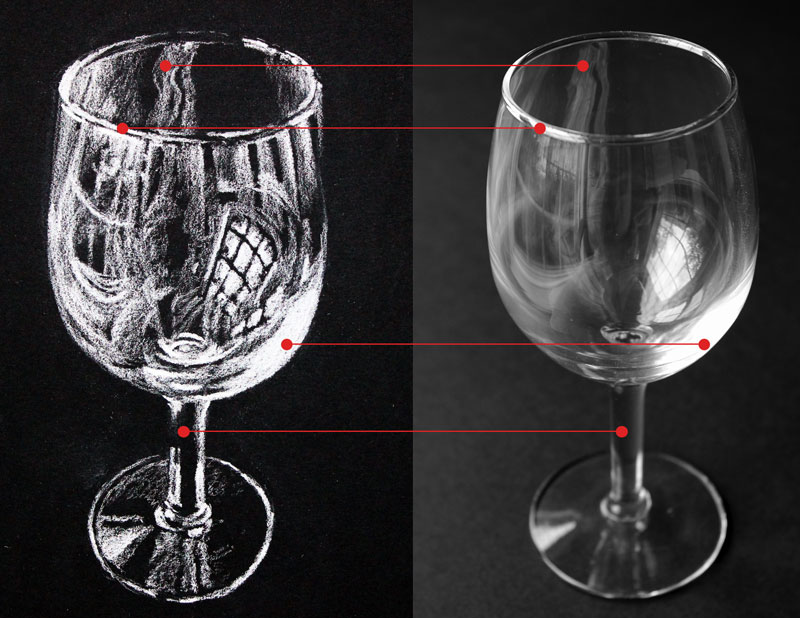
- Watch this demonstration (Membership required)
Because it tells us so much about the light, getting the value as close as possible to what is observed is crucial. It is one of the most important things to look for when you are drawing “what you see”. It doesn’t have to be perfect, but try to match the observed values as closely as you can.
Look For the Form
The form of the subject is communicated through the value that exists on the subject. The relationships of those values tell the viewer about the form of the subject.
Most objects will have defined areas of value which can be identified.
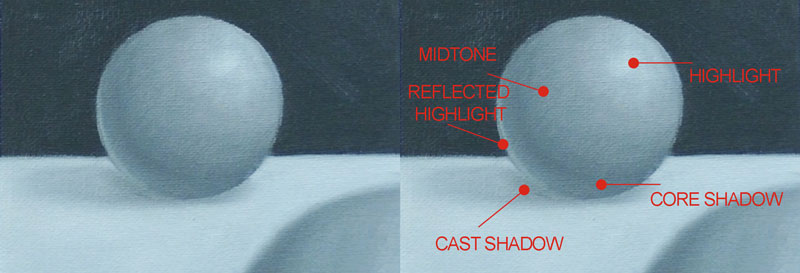 Above image from “The Oil Painting Master Series” course.
Above image from “The Oil Painting Master Series” course.
- Highlight – The location on the subject where light is hitting most directly.
- Midtone – Area on the subject of middle value, often the local color of the subject.
- Core Shadow – Area on the subject in shadow
- Reflected Highlight – Locations of value lighter than the core shadow that result from surrounding objects or surfaces bouncing light onto the main subject.
- Cast Shadow – Shadows that are cast on surrounding objects or surfaces as a result of blocked or partially blocked light.
The positioning of these locations of value tell the viewer about the light and the form of the subject, so it makes sense that we should be looking for them on the subjects that we draw or paint. When we position them correctly, the illusion of form is created.
Look For the Textures
Just like form, texture is communicated in a drawing or painting by the relationships of value. The directional marks, whether they be made with a pencil or with a brush also play a role.
In combination, the directional marks and the relationships of value lead to the illusion of texture.

Above image from “The Colored Pencil Course”.
The directional marks that are made often “flow” over the form of the subject. These implied lines are sometimes referred to as “cross contour lines”. Not only do these lines communicate the texture on the subject, but they can also tell us a bit about the form.
Look For the Colors
Of course, the color is important in an observational drawing or painting and should be observed closely. The trick in applying the color does not necessarily lie in the observation, but instead in how those observed colors are to be mixed.

Above image from “The Watercolor Workshop”.
Mixing colors requires a bit of practice and experience with the medium. Different mediums require different mixing techniques. You don’t mix oil paints in the same manner that you mix colored pencils, for example.
And while matching the color as closely as possible may seem incredibly important, the value of the color applied is actually a greater factor. Colors can be completely altered, but if the value is matched, then the subject is still communicated.

Of course, with observational drawing and painting, you’ll want to match the colors as closely as possible. You don’t want to paint a portrait of someone and make them green (unless they are a Martian or are very sick). I include the image above to demonstrate the importance of value and to point out that if you’re off a bit with the color, it’s typically okay – as long as the values are close.
The Theme
Have you noticed a theme? If you’re keen, you’ve probably noticed that the six things listed here are six of the seven elements of art…
- Line
- Shape
- Form
- Value
- Texture
- Color
The only element missing is “space”, which is communicated through a variety of factors including placement, value, color, detail, overlapping, and size.
The key to “looking” lies in knowing what exactly to look for. When we create an observational drawing or painting, we communicate the subject through the elements of art.
It only makes sense that these elements are what we look for on our subjects when we “draw what we see.”
If so, join over 36,000 others that receive our newsletter with new drawing and painting lessons. Plus, check out three of our course videos and ebooks for free.
Want to Learn How to Paint? Better Learn How to Draw.
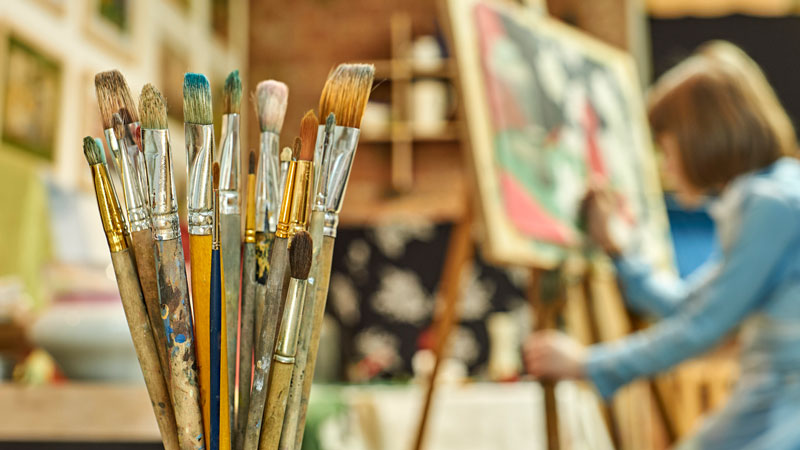
The reality is that drawing and painting go “hand in hand”. Learning how to draw is a stepping stone to learning how to paint. Concepts learned from drawing carry over into painting, and understanding painting concepts actually improves your drawing. While the mediums used are different, and carry their own set of possibilities and limitations, the thought process of the artist remains very similar in both disciplines.
Learning How to Draw
Drawing is, by definition, marking dry marks on a surface. But there is clearly much more to it than that. When you learn how to draw, you are training your brain to see the world how your eyes see it – instead of how your brain interprets it.
We see the world as a collection of lines, shapes, values, forms, colors, and textures. It is our eyes that see the world in its true nature. It is only when our brain steps in and tells us what we are seeing, that the information that we take in from eyes makes sense. When we draw, we train our brains to see what our eyes are seeing – blocking our minds from telling us what we are drawing.
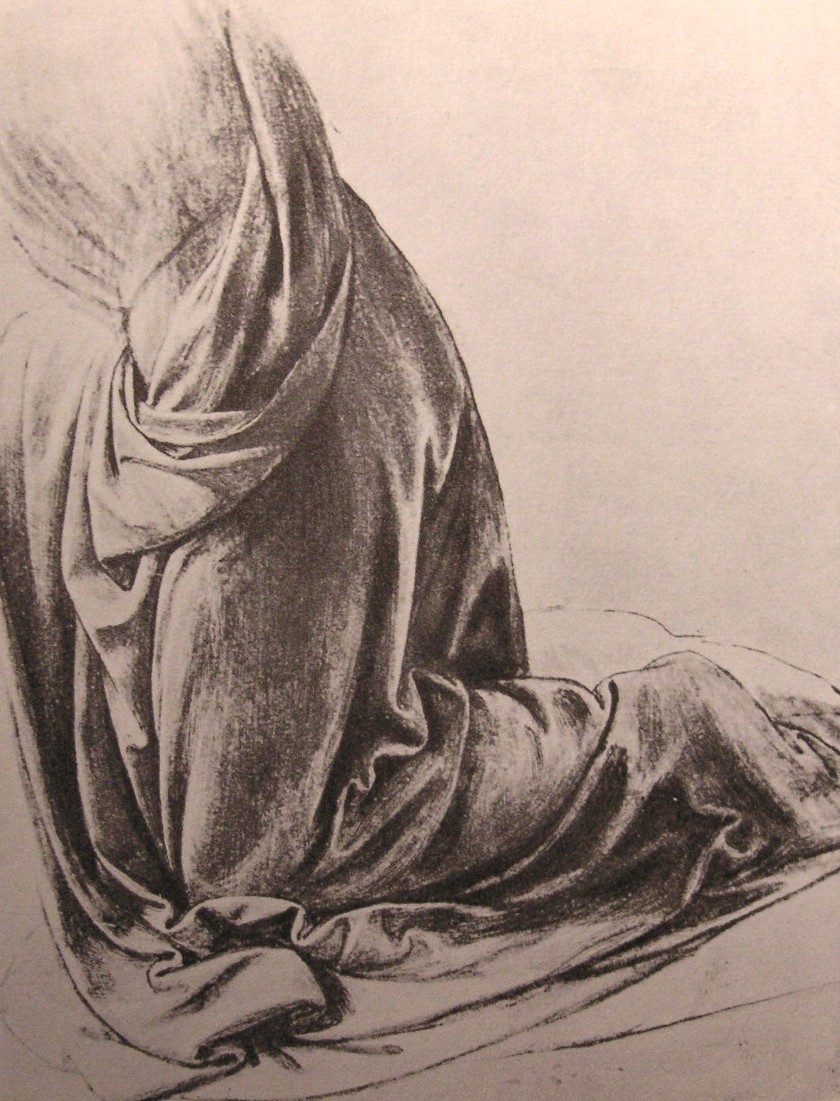
The marks that are made on a flat surface are placed there to create an illusion that actually tricks the minds of our viewers. So, it is crucially important that we understand how to create these illusions. And in order to understand how these marks are to be interpreted, we must have a firm understanding of how we see. We learn “how to see” when we learn how to draw.
The Relationship of Drawing to Painting
Clearly, the same goal exists in painting. When painting, we are also creating an illusion. One that tricks the viewer’s mind into understanding the scene to be an object, a landscape, or a portrait. It is still the lines, shapes, values, forms, colors, and textures that lead to this illusion. The only difference is that they are applied differently, through a wet medium and typically with a brush.
The processes of any medium vary depending on its characteristics. Colored pencils are applied in a different manner from charcoal, but both are considered drawing. Oil paints are applied differently from watercolors, but both are considered painting.
And while the processes vary, the thought process of the artist remains the same. It is still centered around creating an illusion based on the observed lines, shapes, values, forms, colors, and textures of the observed subject.
This is why line, shape, value, form, color, and texture are all considered elements of art.
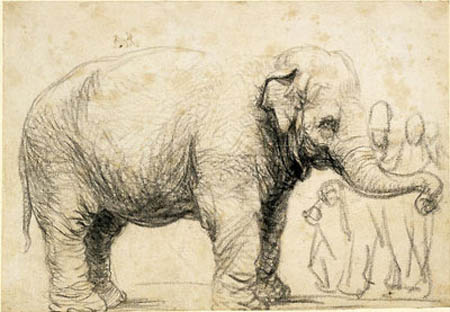
Why You Should Start with Drawing
Drawing, in most cases, is more immediate than painting. The artist can make marks quickly and evaluate the results of their efforts in a shorter amount of time. In painting, often the process is slower, so feedback is also slower. For this reason, it is best to start with drawing and progress to painting after a firm understanding of how to create these illusions has been developed.
If the learner starts with painting, they are more likely to experience frustration, simply because the process and resulting feedback is slower. The processes involved with painting are also more complex, adding another level of difficulty. But if the learner has already established a strong understanding of exploiting the elements by developing skill in drawing, they are more likely to adapt to learning the processes of painting. Their mind is already trained “to see” so they can concentrate on learning the medium instead of learning both concepts at the same time.
Drawing is fundamental – it is the starting point. It doesn’t matter what direction you want to take your art, it needs to start with drawing. Printmaking, painting, Architecture, and even sculpture are all based on the concepts of what we learn when we draw.
This is the reason that all creditable higher learning programs start their students with drawing. They understand that painting is best mastered after the concepts of drawing have been understood. Painting doesn’t require a mastery of drawing, but it does require a “healthy” exposure to it.
If so, join over 36,000 others that receive our newsletter with new drawing and painting lessons. Plus, check out three of our course videos and ebooks for free.
How to Market Your Art – A Guide
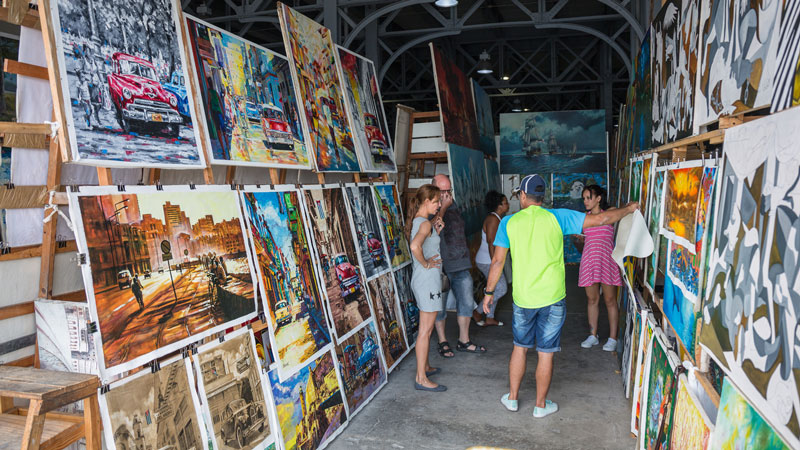
If any of this applies to you, then take heart – you are definitely not alone.
The good news is that you don’t have to be the world’s next “Picasso” to make sells. You just need to know how to sell and selling is a skill that is learned.
Selling Does Not Come Naturally
Selling your art is not something that is natural for most artists. In fact, selling anything is not something that comes easily for most people. But if you are to be a successful artist (meaning that you are selling what you produce), then the reality is that you have to learn how to sell your art. It’s either that, or you have to find someone to sell it for you.
This post explores selling your art through the internet – yourself. Of course, you can always go the traditional route by finding a representative, like a gallery, to sell your work. They, of course, will take a big chunk of your sale price and will undoubtably have a limited reach of potential buyers. That is, if they even accept you and you “fit” into their style. I would not recommend this route to any new artist looking to make art for a profit. There are just too many ways an artist can make money from selling their art today, outside of going through a gallery.
This post will provide you with a strategy for selling your art. I will most likely expand this post into a full course somewhere down the road, because there are so many things to cover. I’ll try to cover everything I can on the surface here, but realize that each one of the topics below can be expanded much, much further.
The Mindset
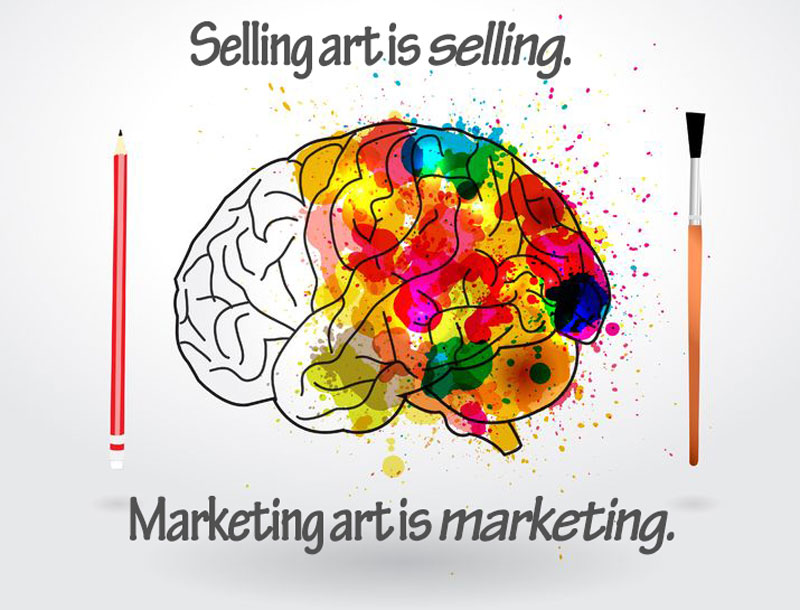
Selling art is selling. Marketing your art is marketing. Selling and marketing require work – sometimes lots of it. You’ve got to understand, that if you are selling your art, then you are selling a product that you produce. This means that your patrons, people who purchase your art, are your customers.
Potential customers do not just “materialize” out of the air. You have to go find them, because they will not come to you. And once you find them, they still may not purchase from you. In other words, you have to create a customer base of potential buyers and a few of them will likely purchase from you.
Too many people think that if they just share their work on a site (like Etsy), then it will sell. While it is possible to make a couple of sales this way, you really need to build a group of potential buyers to see real results.
The good news is that there has never been a better time to do this in the history of mankind. The internet has made it incredibly easy to build a pool of potential customers.
Building Your Audience
We’ll call this “pool of potential customers” your audience. This is because you will be creating a group of people in which you communicate “what you do” and “why you do it”. If your audience likes what you have to say, then they are likely to purchase the art that you produce.
Sure, you will have the occasional buyer that will purchase your art based on simply seeing it. But no one will ever see it if you do not build an audience to help you get your art in front of the eyes of that potential buyer.
So the first thing you need to do is build your audience.
These people will share your work, tell others about it, and eventually buy from you. They will become your “army of salespeople”.
We’ll delve into how you will build your audience in a moment, but first, your website.
Your Website
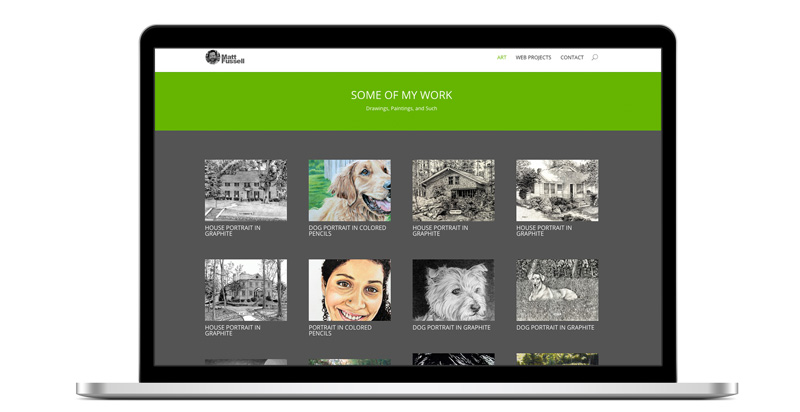
Before we get too far ahead of ourselves, we need to discuss the hub of your promotional efforts – your website. If you are to sell your work, then you absolutely must have a website. No exceptions here. Your website will be your “number one” source of building your audience.
Your website is how you will primarily communicate to the audience that you build. It is not only where you will showcase your work, but also where you will attract potential buyers and most importantly, build trust with that audience.
Your website needs to look professional, while clearly communicating what you’re all about as an artist.
A great example of a professional looking website is that of Emily Winfield Martin. She is also one of the most successful artists on Etsy. It’s no wonder either, because she is doing quite a number of things right.
Her site has a well organized portfolio, links to her store (on Etsy), a clear way to contact her (via her about page), and a blog. Her website is a “hub” for selling.
So how does she build an audience with her website? One way is through her blog. Just take a peak at her blog and scroll through her posts. Pay attention to the comments. Clearly, she has a dedicated following of people who are potential customers. She is building an audience.
When they are ready to buy, they simply navigate to the “Shop” (on Etsy) and make a purchase.
In fact, just about all of the top selling artists on Etsy have a website or blog. This is not a coincidence.
In an article published on Inc.com, the importance of blogging is addressed. The article, about then top Etsy sellers Ashley Goldberg and Drew Bell, mentions just how important blogging is to their success. The article notes that the early success of the duo was in large part due to the following that Ashley had already built through her blog. It goes on to say that since Etsy consists of largely handmade objects, people want to know who people are, what they are in to, and why they make what they do.
The way you communicate these things to your audience is through your website. Blogging and posting on a regular basis provides insight to your audience as to who you are and why you create what you create.
How to Build Your Website
Clearly, a website is a necessity for any artist that wants to sell their work. But the thought of having to build one can be scary for some.
Most people think that you have to be a computer programmer or a web designer to build one. You don’t. In fact, you don’t even need to know how to write one line of code. Creating a website is easier than ever and anyone can do it.
I’ve created a guide for building your own portfolio website from scratch in just a few minutes. This tutorial uses the popular and easy website building platform of WordPress. You can check it out here.
But building your website is merely a small step. You’ll need to do more to start bringing people to your website, making them fans of your work, and most importantly you.
Leveraging Social Networks and Search Engines to Sell Your Art

Before you can expect any real traffic to your website, you’ll first need to find our audience. In order to do this, you need to go to where they are. Remember, they will not come to you.
And where are people on the internet? Facebook, YouTube, Google, Pinterest, Instagram, etc. This is where you will find your audience. These are the places where you will attract your target market and then send them to your website, and eventually your “Shop”.
Here are a few ways you can leverage these resources to start building your audience…
Facebook – Create a Facebook fan page where you post your art. (Don’t post all of your art at one time though. Share it over time.) Share your page with your friends and family at first and encourage them to share with others as well. Soon, you’ll have a nice little following on Facebook.
Artist Natasha Wescoat was able to make $50,000 selling her art exclusively through Facebook. You can read her story and learn how she was able to build such a huge following here. Also, be sure to check out her very active Facebook page where she currently has 47,000+ fans.
YouTube – YouTube is the second largest search engine on the planet. YouTube has over 1 billion users, yes that’s with a “b”. That is an incredibly large pool of potential customers.
Create a YouTube channel and start creating videos of you talking about your work, your process, and perhaps you creating your art. Be sure to mention and link to your website in the video so people that are interested in you and your work will know how to learn more about you.
There is currently a countless number of artists that are leveraging the power of this platform to reach their audience.
It may be slow at first, but over time you’ll start to see a few subscribers and more visitors to your website.
Don’t be afraid to show your face on camera and let your personality show through. Do what you can to connect with the people that may potentially buy your art in your videos.
Pinterest – Pinterest, by far, is one of the most visual social networks out there. Because of its visual nature, it is a perfect place to start sharing your art.
Create several boards of your work and share them with others. Every time you create something new, post it to your boards.
Over time, you’ll start to attract followers and if they like what you are creating, they’ll start “repinning” your art to their boards. As long as you post on a regular basis, it will just continue to grow from there.
Google – I mention Google here, but I’m really referring to any of the search engines out there. When you have a website, some people will find you by conducting a web search. This is assuming that you are posting consistently on your blog.
Post on your blog every time you create a new work. Discuss your process, your inspiration, and the materials that you used.
Write about other artists that inspire you. Offer tips to help others that may want to create art in a similar style as yours.
The more content that you share, the more web traffic you will possibly receive from the search engines. Don’t expect a flood of visitors at first. Traffic from search engines requires consistent posting and quite a bit of content.
Concentrate on one of the resources mentioned above at first, and see what works best for you. Don’t try to enter all of them at the same time. You’ll become overwhelmed if you do.
No matter which resource you decide to concentrate on at first, remember that your goal is to direct people back to your website where they will dig deeper into what you’re all about as an artist.
Connecting with Your “Audience”

Once your potential customers have made it to your website, the work is far from over. You’ll now need to connect with them further.
You’ll connect with your audience through your work and what you write on your blog, but you’ll also want to connect with them after they have left your website.
In order to do this, you may consider creating a “newsletter” that you can email to your potential pool of customers on a regular basis. You can email them every time you post to your blog and when you create a new work of art.
An email list will bring your potential customers back to your website and back to your art, making sales a greater possibility.
You can create a convenient place for them to sign up for your newsletter somewhere on your website, like in the sidebar, or at the bottom of your blog posts.
You may also consider offering an incentive for them sign up to your “newsletter”, like perhaps a free “printable” of one of your works.
In order to have an email list, you’ll need to signup with a service that handles the sending of the emails. Here are a couple that I recommend…
AWeber – AWeber provides you with a simple interface and over 6,000 stock photographs that you can use to spruce up your emails. They offer a 30 day trial for free, which goes up to $19 a month for up to 500 subscribers.
MailChimp – MailChimp offers templates to make your emails look great. They offer their services for free for up to 2,000 subscribers but there is a limit to how many emails you can send. For the auto responder feature to work, you must pay for the services and if you are offering something for free when people sign up (like the free printable), then you’ll definitely need that feature.
Both services provide you with a form that can easily be embedded into your website to collect emails.
Once you start getting those subscribers, be sure to email them frequently and “stay in touch”, but don’t over do it. I’d say an email every few days is plenty.
Remember, your goal is to send your audience back to your website, so include links in your emails back to the art that you are producing.
Final Thoughts
If you are wanting to sell your art, then you clearly have to do much more than make art. You have to market your art. You have to think of yourself as a brand and the art that you make as your product.
Of course, there are plenty of additional ways to sell your art that do not involve the internet. This post is clearly just about selling your work on the internet which is undoubtably the easiest and fastest way to start making sells. And when I say “fast”, I do not mean “over night”.
Honestly, we have only begun to scratch the surface here. As I mentioned in the beginning of the post, I could go much deeper into each one of these topics.
It will take patience and perseverance, but if you market your art (and yourself) properly, then you will make sales.
I’d love to hear your thoughts. Are you selling your work? Are you having any success? Are you failing? Are there any strategies that I’ve missed. Be sure to add your comment in the comments section at the bottom of the page.
If so, join over 36,000 others that receive our newsletter with new drawing and painting lessons. Plus, check out three of our course videos and ebooks for free.
The Inner Artistic Struggle We All Fight

It’s no wonder that many of us become discouraged by this thinking and doubt starts to enter our minds. You may think, “it’s not easy for me, so I’ll never be able to reach this level of skill.”
Although some accomplished artists will never discuss this or admit it, the truth is that art is a struggle – for everyone. It doesn’t matter your skill level.
The Inner Struggle of Creating
Every work does and should include a bit of a struggle. It is never “easy”, nor should it ever be. Although the finished work may look “effortless”, it never is.
If we succumb to the thinking that artistic skill is a talent that is somehow “effortless” for some, we also start to believe that if it is a struggle for us, then we are somehow lacking.
“The harder the struggle, the more glorious the triumph” – Swami Sivananda
I have never created a work that didn’t include a battle with my own doubt. I am constantly questioning my decisions throughout the work. It is an inner conflict of thought and execution.
This doesn’t mean that I am lacking confidence in what I am producing. It’s just part of the process. And again, every artist goes through this, in every work of art.
It is the struggle of production that ultimately leads to the satisfaction that many of us love about creating. The artifact that is produced becomes a record of our victory. The satisfaction that comes during art production is often the result of small battles won – commanding the material and speaking from our soul. This may be one of the reasons that we become so attached to what we create.
Struggling is part of it. You should expect it and embrace it.
Don’t Give Up
The unfortunate truth is that too many new artists lose the inner battle. They allow their thoughts of doubt to stifle their art and their development of skill. Over time, they simply give up.
But if we know that struggling is part of creating art, we can cope with it when it comes. And instead of giving up, we face the battle and may even find enjoyment in it.
Sure, not every work will be a success and not every decision will be perfect. But art is not about perfection and success is only earned after failure. The only true failure is giving up.
How to Win the Battle
So, how do we overcome the doubt? How do we recover when we think we have made a irreversible mistake?
The answer is simple. We learn from our mistakes, continue to grow, and keep producing. With each work, we become stronger. We continue to work through the voice of apprehension. And although the doubts will never be silenced completely, they will become quieter with experience.
Knowing that your struggles are normal and experienced by other artists means that you are not alone.
Take comfort in knowing that even the greatest artists fight off feelings of doubt and inadequacies from time to time.
Accomplishments are Born From Struggle
No accomplishment, no matter if be art-related or not, is without its struggle. If it were easy, then it wouldn’t be a significant accomplishment. Therefore, it is the overcoming of adversities that often lead to our greatest accomplishments. Each work that we produce is an accomplishment.
Think of the things in life in which you are most proud, your accomplishments and achievements. I’ll argue that none of them came without a struggle.
Your Thoughts
So, how do you feel about your art? Do you fight those feelings of doubt? Are they overwhelming at times? I’d love to hear your perspective. How do you cope and work through? How do you win the battle?
If so, join over 36,000 others that receive our newsletter with new drawing and painting lessons. Plus, check out three of our course videos and ebooks for free.
5 Things I Learned in Art School
In this post, I’ll share five things that I did learn in art school. When I entered art school, nearly twenty years ago, I never could have predicted that these five things would be the biggest “take aways” from my experience. But each of them has been incredibly important in my personal growth as an artist.
I Learned That There is Competition
I remember that first day in my freshman drawing class as clearly as if it were yesterday. My class had about 20 students, and all of them were strangers. I remember looking around wondering, “who is the best? Is it her? Is it him? Is it me?”
You see, I am “over the top” competitive. I have always strived to be the best in every endeavor that I undertake. This can be an advantage, but it can also be a huge character flaw. We all know that you cannot always be the best at everything.
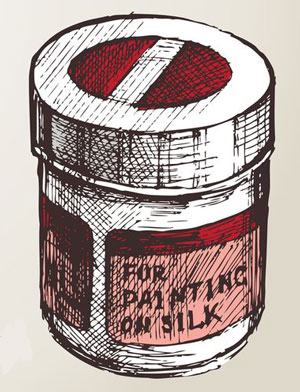
When it came to drawing, I had always been the best (in my high school anyway). But I quickly learned that art school was going to be a different story. If I wanted to be among the best, I was going to have to work for it. I learned this during my first critique.
I spent about 3 hours on that first assignment. The drawing was an 18” by 24” graphite illustration of one of the seven deadly sins. Up to this point, 3 hours on one drawing was quite a long time for me.
As my classmates and I pinned our work upon the wall, I quickly noticed that mine wasn’t the best. It wasn’t the worst by any means, but it wasn’t the best. For someone as competitive as myself, this was devastating. Before the critique even began, I knew that I could do better.
Competition drives excellence. It also separates those who are willing to work hard from those aren’t. There was clearly competition for me among my classmates. Now the question became, “am I willing to work hard enough to reach excellence?”
Now that I have years of experience under my belt, I know that in order for me to have reached my potential for that drawing, in that particular style, I would have needed to spend many more hours on it. Additional time should have been spent on better research, thorough execution of the medium, and developing a clearer manner in which to communicate the idea. But I have only learned these things because of the competitive spirit that drives me to be better.
I Learned The Value of Critique
I have never met someone that likes to be told what they have done wrong, or where they could improve. So, it’s no wonder that so many students are resistant to critique. After all, this is what critique is all about – being told what you have done wrong, or where you could improve – right?
During my first year of art school, I would dread critiques. While I loved sharing my work, I couldn’t help but feel that I was being evaluated during each session.
It was only when I separated myself from my art that I began to see the real value of critique.
I had to look at my art as a product, rather than an extension of myself. This is hard to do as an artist. We express ourselves through our work, and we can’t help but to be somewhat attached to it emotionally. But in order to improve, we must learn to view our art objectively and this requires detachment from the work.
When I shifted my mindset, I quickly began to benefit from critiques. I understood that not everything that I create will be success, but in every work I can grow.
Each critique offered insights on how my art was viewed and how I could communicate in a clearer manner.
By graduation, I was looking forward to every critique. Not because I wanted to share what I had done, but because I wanted to grow from what advice others would share.
I Learned That “Talent” Can Be Learned
From very early on in my life, people labeled me as talented. For a long time, I graciously accepted this label. However, over time it began to frustrate me.
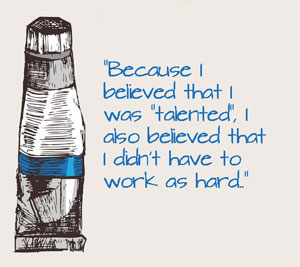
Up until art school, I believed that my drawing abilities were the result of the “talent” that I was “fortunate enough to be born with”. This misbelief actually hindered my growth as an artist.
Because I believed that I was “talented”, I also believed that I didn’t have to work as hard.
When I finally realized that artistic growth has absolutely nothing to do with “talent”, my skills began to improve. I started doing my own searching and as I grew, my thirst for knowledge intensified. Soon, I was creating art that I thought I would never be capable of producing.
I had to let go of “talent” and embrace the idea that drawing and painting are skills that can be learned and developed by anyone. Our “starting points” may be different, but the limits of where we can take our skills are limitless.
I Learned New Processes and Mediums
Our experiences shape who were are as people. Our exposures to artistic media sometimes shape who we become as artists.
When I entered art school, I had only been exposed to a few mediums. I had never touched a soft pastel and I didn’t have a clue as to what Lithography was all about. I had never painted with oils and I was convinced that the medium for me was pen and ink.
My exposure to a variety of media and processes in art school changed all of that and formed who I became artistically. Now, pastels are one of my favorite mediums and I only rarely work with pen and ink.
I Learned That Success in Art Requires Hard Work and Perseverance
So by now it should be clear that success in art takes hard work. If you really want to become a strong artist, you must be willing to put in the hard work and “hours” that it requires. Far too many people expect immediate results and quickly become disappointed when they do not get them.
Drawing and painting are lifelong journeys. Developing your skills should be approached as a marathon, not a sprint.
If so, join over 36,000 others that receive our newsletter with new drawing and painting lessons. Plus, check out three of our course videos and ebooks for free.
5 Things I Never Learned in Art School
Call this a disclaimer if you like, but each person will have a different experience with art school. Each experience, each school, and each personality is unique. My journey took me through two different programs at two different schools.
In this post, I’ll share what I didn’t learn in art school. In the next, I’ll share what I actually did learn.
I Never Learned How to Draw
 Surprise, surprise. I didn’t learn how to draw in art school, well not directly anyway. I thought that I would. Many students think that they will learn a few magical secrets that will propel them to greatness and most think that their professors have the all of the answers. I quickly learned that my professors could tell you what you did wrong, but couldn’t seem to provide answers on what you need to do to fix it.
Surprise, surprise. I didn’t learn how to draw in art school, well not directly anyway. I thought that I would. Many students think that they will learn a few magical secrets that will propel them to greatness and most think that their professors have the all of the answers. I quickly learned that my professors could tell you what you did wrong, but couldn’t seem to provide answers on what you need to do to fix it.
So, I did my own searching for answers. I developed my drawing skill by accepting that answers needed to be found. They were not to be “gifted” to me from my professors. (Perhaps they didn’t have the answers in the first place.)
Developing a portfolio for college? See: Art Portfolio Tips
I discovered that drawing was a skill that required a thirst for knowledge, a real passion for the craft, and dedicated practice. It wasn’t until I fully devoted myself to improving my skills (on my own) through research, self-discovery, and practice that my drawing abilities started to improve drastically.
Along the way, as I taught myself, it become clear to me how I could teach others. Perhaps this is one of the reasons I became a teacher.
I Never Learned How to Paint
 It should come as no surprise that I didn’t learn how to paint in art school either. Sure, I was exposed to painting in various forms, but techniques weren’t shown to me. We were given assignments and time to complete them. Our work was then critiqued at the conclusion.
It should come as no surprise that I didn’t learn how to paint in art school either. Sure, I was exposed to painting in various forms, but techniques weren’t shown to me. We were given assignments and time to complete them. Our work was then critiqued at the conclusion.
One of my professors kept one of my paintings to use as an example, but never told me why he kept it or what I had done correctly.
I’m reminded of the movie, “Art School Confidential” (affiliate link. Just like in the movie, our professors gave vague assignments, walked around during studio time, occasionally nodding in approval, and then a critique would follow. (By the way, if you attended art school and have never seen this movie, I highly recommend it. It’s not a “family” movie by any means, but the stereo types of the characters are “spot on”.)
Sometimes, paintings that were clearly awful got a lot of attention and even praise from the instructor. Usually it was because they were “breaking the mold” as the professor would say. But most of us knew it was because they simply couldn’t paint any other way.
I Never Learned How to Market My Art
The reality is that art is a business. By nature, successful artists are also entrepreneurial. The unsuccessful ones shy away from selling or marketing. Sure they may have great vision, skill, and execution, but nobody will ever see it. Van Gogh was an artistic genius, but a miserable business man.
Finding financial success as an artist requires both artistic skill and business savvy. Marketing yourself as an artist, no matter what the speciality, is crucially important.
Surprisingly, I never learned how to market my art in art school. Back in those days, it was all about “tear sheets”, which where printed samples of our work that were sent to publishers, galleries, and so on. All we were told was to make them and send them out. No direction beyond that was ever given to us as students.
Luckily, it is very easy to market yourself as an artist today. A website can be created in a day, by just about anyone.
Here’s a guide on how to create your own site in a matter of minutes…How to Create an Online Portfolio Website.
Art can be sold online through various online vendors, like Etsy. Here’s a guide on selling your work through Etsy…How to sell Your Art On Etsy.
Beyond that, it is simply a matter of persistence and hard work.
I Never Learned How to Make a Living as an Artist
Marketing your art is one thing, but actually making a living as an artist is another. I didn’t learn how to make a living as an artist in art school. I didn’t learn how galleries worked with artists and how dealers worked with collectors. Again, I had to do my own research on these things.
Believe me, it came as a real shock to learn that some galleries would take a 50% cut of the price of the work and some as much as 60%.
These days, artists can work directly with patrons by selling online and keep 100% of the price of the work. This reduces the price of the work and allows the artist to make more money.
I Never Learned How To Roll Film into the Spiral Film Holder in the Dark
I spent 6 years in art school in total. (It wasn’t because I had bad grades, if you were wondering – I graduated Cum Laude). In that time, I took almost every studio class available. Printmaking, Illustration, Sculpture, Painting, and Figure Drawing were the standards, but I also took classes that were outside of my concentration. For example, I took a class on Lithography and even a class on making musical instruments from clay (one of my favorites).
But then there was Darkroom Photography. It wasn’t even called “Darkroom Photography”, because all photography was created in a darkroom. (Digital cameras were new and very expensive.)
I can’t tell you how many rolls of film I destroyed trying to loop through that scroll in the dark. Each time, I destroyed the roll. For a college student with limited funds, this was extremely frustrating.
Luckily, I was able to find a classmate that performed this task for me. To this day, I have never learned how to do this properly. Thank goodness for digital cameras, because without them, I’d literally still be “in the dark”.
It may sound like I didn’t learn much of anything in art school, but this couldn’t be further from the truth. I learned quite a bit in art school and I’ll share what I learned in the next post.
What about you? Are an art school graduate? Are in art school now? Are you considering going to an art school? What are your experiences?
If so, join over 36,000 others that receive our newsletter with new drawing and painting lessons. Plus, check out three of our course videos and ebooks for free.
3 Things You Can Do to Improve Your Drawing Without Picking Up a Pencil
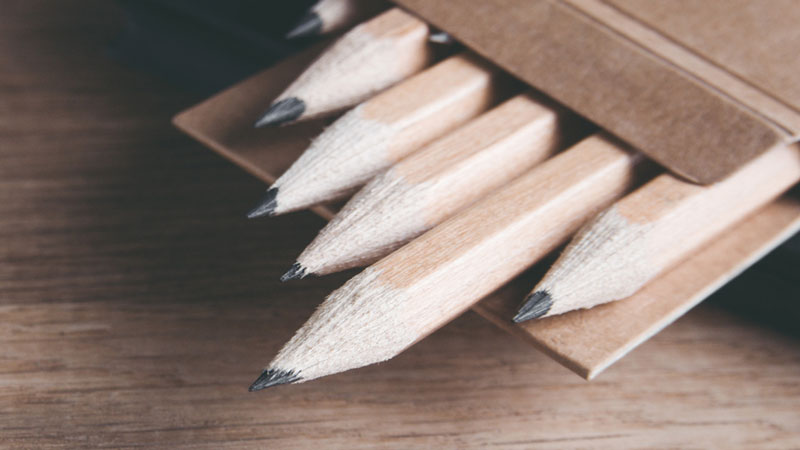
Yes, you read that right. Now I understand that there may not be many situations where you would be without a pen or a pencil when you want to work on your drawing skills. So, while this list may not be the most practical, it does shed some light on how we might can improve how our minds perceive and make sense of the subjects that we draw.
A major misconception with drawing is that it’s purely a process of making marks on a surface. And while it’s true that drawing is about mark-making, it’s also about understanding the subjects that you are drawing and our how mind makes sense of them.
Drawing is about understanding how we see. So if we take steps to better understand how we see and understand the objects around us, our drawing skills will naturally improve.
Imagine Drawing the Subject in Your Mind
Visualization is a powerful tool. When we visualize the drawing process in our mind, we train our brains. Even without making any marks, we are essentially giving our brains practice. The more practice that we give to our brains, the better they become at interpreting the world around us.
In fact, visualization is proven to produce results. A study by Dr. Blaslotto conducted in 1966 proves just how powerful it can be. The study involved basketball. Three test groups where each asked to perform different tasks…
Group A was asked to do nothing – no practice or anything basketball related.
Group B was asked to practice free throws everyday for 30 minutes over a 30 day period.
Group C was asked to come to the gym everyday and simply visualize making free throws for 30 minutes over a 30 day period.
After the 30 days, the results were in.
Group A did not improve or worsen.
Group B improved by 24%.
Group C improved by 23%.
So without any physical practice, Group C improved almost just as much as Group B – simply through visualization.
Just like basketball, drawing is a combination of both physical and mental activities. So, visualization can only help us improve.

So what can we look for when we visualize the drawing process? Look for the lines, shapes, values, and colors on the subject and simply imagine how you would draw them. Visualize the marks that you would make to communicate the object.
Visualization is a great “pre-drawing” ritual as well. It gets your mind in “the right place” before the marks are made.
Create a Collage
When a collage is created, torn or cut pieces of paper are arranged to create an image. During the process, decisions are made concerning the shape and size of each piece of paper and how they should be arranged on the surface. The tone and hue of the paper are also considered.
When we draw, we make similar decisions. We decide the shape of objects, values, and colors in our drawings. We simply draw them instead of tearing or cutting them out.
So by creating a collage, you are essentially working some of the same “brain muscles” that you would work if you were drawing. And the more that we exercise those “muscles”, the stronger they become.
Now, just like any art form, collage comes in many different forms. Representational collages will help out with your drawing skills. You can find a few good examples by artist, Megan Coyle here.
Create a Sculpture
Sculpture is all about form. When we sculpt, we have the opportunity to really get “hands on” with form. We end up having a better understanding how form works and how our brain interprets it when we work with it directly.
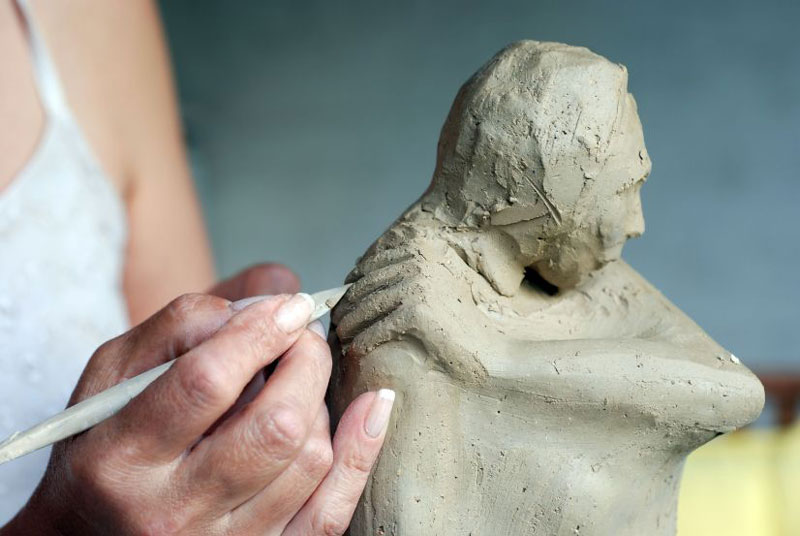
Since drawing often requires the artist to create the illusion of form, it makes sense to become better acquainted with it through the creation of a sculpture. In essence, creating a sculpture will actually lead to better drawings as well.
The actual process of drawing will improve your skills the fastest, but there are other avenues to explore. Anything that you can do to help train your brain to see will help and these activities are great places to start.
If so, join over 36,000 others that receive our newsletter with new drawing and painting lessons. Plus, check out three of our course videos and ebooks for free.
The Creative Process

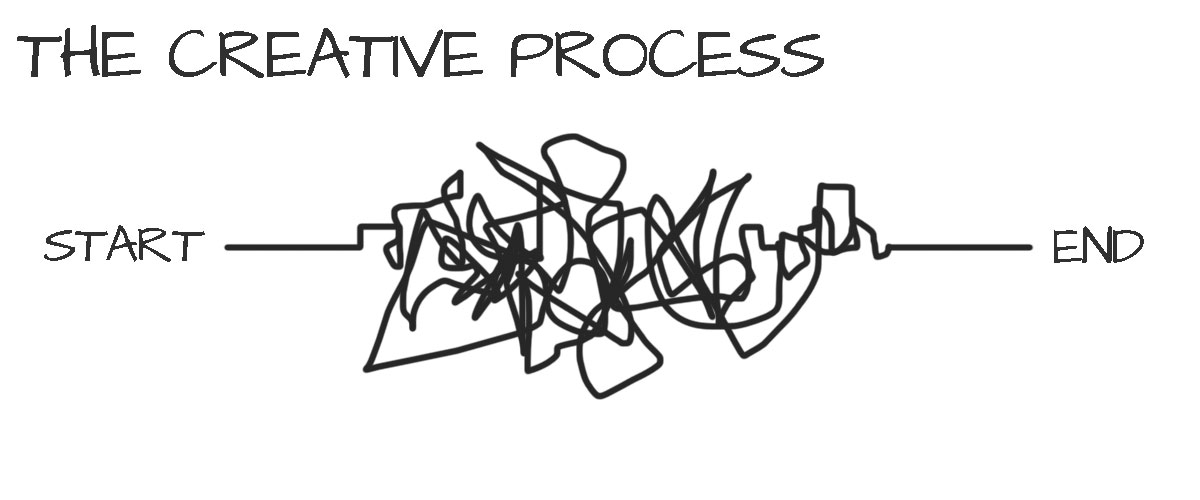
The truth is that we all approach what we create differently. And although this post is about “the creative process” in general, the actual steps involved will vary from person to person. For some, the process is easy. For others, it can be torture.
The Brain
The creative process requires the use of both sides of our brain. The free thinking right brain controls our ideas, inspiration, and most of the production process, while our analytical left brain is in charge of evaluating, reworking, and sharing.
Most of us have one side of our brain that seems to dominate making parts of the process easier and others more difficult. If you are mostly a “right-brained” individual, then the evaluation and sharing parts of the process may be more difficult for you, while the ideas seem to flow uncontrollably.
“Left-brained” individuals will have an easier time with evaluation, (sometimes over evaluating), while ideas are sometimes harder to come by.
Are you left or right brained? Watch the video below from BuzzFeed.com to find out…
Before going any further, I think that it’s important to point out that left-brained people can be very successful artists. There is a misconception that all artists are dominated by the right hemisphere of their brain, and that left-brained people are just a bunch of mathematicians. This couldn’t be further from the truth.
Strengths and Weaknesses
Understanding your strengths (and weaknesses), and accepting them, is important to finding success in anything in life, not just creating art. Understanding what parts of your creative process may trip you up will help you get through those steps, so that your creativity will continue to flow and that you continue to be a productive artist.
As I mentioned before, we all approach creating differently. However, most of us will flow through some form of each step that follows.
Steps of the Creative Process
1. Inspiration – We are all inspired by different things. It may be an object, a person, an experience, a song, or even a feeling. But one thing is common – our inspiration comes from an external source.
To make the most of what inspires us, we need to make an effort to look for it. Instead of waiting for inspiration to strike, put yourself in a position to be inspired. If music inspires you, listen to as much of it as possible. If you are inspired by a person, spend more time with them.
2. Idea – Your idea and your inspiration are different. For some, the idea comes almost immediately after inspiration, making the distinction between the two a little more difficult to detect. For others, the idea solidifies gradually over time, after the initial inspiration. Unlike the source of inspiration, the idea is born internally. It is unique to the artist that conceives it.
3. Research – This step can also be considered as planning. We may sketch out our idea or research methods and/or media to communicate our newly formed idea. Sometimes, the idea may change at this stage, taking on a new life or direction.
4. Production – The artifact is created in the production stage. The inspiration has led to an idea, the planning and research have been completed, and the art is now being produced. The idea is now transforming into a visual communication that is reflective of the artist that creates it.
5. Critique – The process now shifts from a creative endeavor to an analytical one. The artist must now remove themselves from the work, recognize the flaws, and make the necessary changes.
It is my opinion that critique should not be viewed as an evaluation of the finished work, but rather a “check” on progress towards a goal. For some artists, it is difficult to view their art as a “product”. But this is essential if the art is to reach its full potential. Critique is decidedly a left-brained part of the process and should be approached with an analytical, open mind.
6. Rework – With flaws exposed and recognized, the art is revisited. Changes are made based on the judgments made in the critique.
7. Evaluation – It is not until all changes have been made to the art that the evaluation of the success or failure of the work is decided. Strengths of the work should be noted, so that they may be incorporated in future works. Weaknesses should also be recognized, so that they may be avoided in future works. It is important to remember that it is the work that is evaluated, not the artist.
8. Presentation – Art is meant to be shared. Whether that be in a prestigious gallery or on the walls of your home, your art should not be hidden away. The last step of the creative process is to let your your voice be heard.
We are all unique as artists and we all approach how we create differently. What are your thoughts on the creative process? How do you create?
If so, join over 36,000 others that receive our newsletter with new drawing and painting lessons. Plus, check out three of our course videos and ebooks for free.

